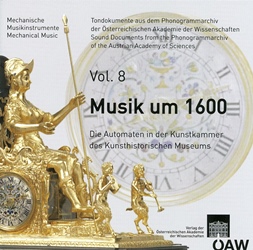
Die Kunstkammer des Kunsthistorischen Museums birgt fünf Objekte (vier Tischautomaten und einen Kunstschrank), die mit Musikautomaten ausgestattet sind: Der Trompeterautomat (1582), das Schiff (1585), der Bacchuswagen (um 1602/06), der Walbaumschrank (um 1620/25) und der Minervawagen (um 1625/30) zählen zu den frühesten Klangzeugnissen der europäischen Musikkultur. Im Zuge der jüngsten Restaurierungsarbeiten war es möglich, die Musik dieser Automaten wiederherzustellen. Aus konservatorischen Gründen waren einer Instandsetzung des Trompeterautomaten, des Schiffes und des Bacchuswagens Grenzen gesetzt und die klingende Musik konnte nur mittels Rekonstruktionen wiederhergestellt werden. Die teilweise sogar gut erhaltene Notation der Musik auf den Informationsträgern (Rädern und Scheiben) und die noch funktionstüchtigen Pfeifen und Trommelmembrane der Automaten begünstigten die Realisation der ursprünglichen Musik unter Verwendung des historischen Tonmaterials. Der Minervawagen und das Orgelwerk im Walbaum-Schrank überraschten durch einen guten und weitgehend vollständigen Erhalt ihrer Musikwerke und ihres Antriebs. Diese beiden Automaten konnten ihre Musik wieder selbständig wiedergeben. Die Automaten spielen zu einer bewegten Szenerie ein thematisch passendes Musikprogramm. Diese erstaunlich komplexe Musik steht im Zentrum des Zusammenspiels der Künste. Den Tonaufnahmen ist eine Transkription aller Musikstücke beigefügt.
…
The Kunstkammer of the Kunsthistorisches Museum holds five automata (four table automata and one art cabinet) with inbuilt organ works: the trumpeter Automaton (1582), the imperial ship (1585), the Bacchus carriage (ca 1602/06), the Walbaum cabinet (ca 1620/25) and the Minerva carriage (ca 1625/30). These objects have to be rated as one of the earliest musical automata and sounding sources existing. In the course of recent restoration works it was possible to recreate their musical output. Due to conservational reasons the music of the trumpeter automaton, the imperial ship and the Bacchus carriage had to be reconstructed. The realization took advantage of partly well-preserved musical information on the automata’s program carriers (discs and wheels) and of the still functioning pipes and drums of the automata. Thus the reconstructions give the true and authentic sound of the historical performance. The status of the organ works of the Walbaum cabinet and the Minerva carriage allowed repair of their mechanics and playback of their music. Every automaton presents its scenery together with an appropriate music. Within this interaction of the arts the surprisingly complex music plays an important and central role. The sound recordings are accompanied by transcriptions of all musical pieces.
2013,
978-3-7001-7335-9
Audio CD mit Booklet mit 32 Seiten,
OEAW CD PHA 34